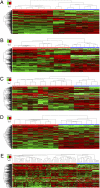Redefining the relevance of established cancer cell lines to the study of mechanisms of clinical anti-cancer drug resistance
- PMID: 22068913
- PMCID: PMC3219108
- DOI: 10.1073/pnas.1111840108
Redefining the relevance of established cancer cell lines to the study of mechanisms of clinical anti-cancer drug resistance
Abstract
Although in vitro models have been a cornerstone of anti-cancer drug development, their direct applicability to clinical cancer research has been uncertain. Using a state-of-the-art Taqman-based quantitative RT-PCR assay, we investigated the multidrug resistance (MDR) transcriptome of six cancer types, in established cancer cell lines (grown in monolayer, 3D scaffold, or in xenograft) and clinical samples, either containing >75% tumor cells or microdissected. The MDR transcriptome was determined a priori based on an extensive curation of the literature published during the last three decades, which led to the enumeration of 380 genes. No correlation was found between clinical samples and established cancer cell lines. As expected, we found up-regulation of genes that would facilitate survival across all cultured cancer cell lines evaluated. More troubling, however, were data showing that all of the cell lines, grown either in vitro or in vivo, bear more resemblance to each other, regardless of the tissue of origin, than to the clinical samples they are supposed to model. Although cultured cells can be used to study many aspects of cancer biology and response of cells to drugs, this study emphasizes the necessity for new in vitro cancer models and the use of primary tumor models in which gene expression can be manipulated and small molecules tested in a setting that more closely mimics the in vivo cancer microenvironment so as to avoid radical changes in gene expression profiles brought on by extended periods of cell culture.
Conflict of interest statement
The authors declare no conflict of interest.
Figures


References
-
- Borrell B. How accurate are cancer cell lines? Nature. 2010;463:858. - PubMed
Publication types
MeSH terms
Substances
Associated data
- Actions
Grants and funding
LinkOut - more resources
Full Text Sources
Other Literature Sources
Molecular Biology Databases
Research Materials
Miscellaneous

